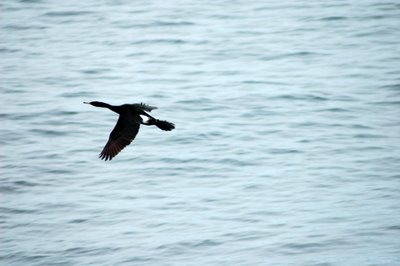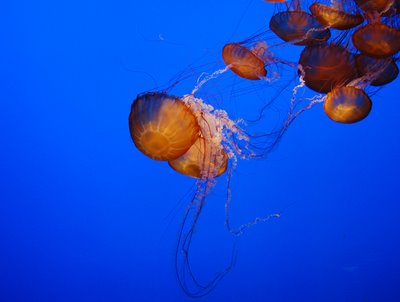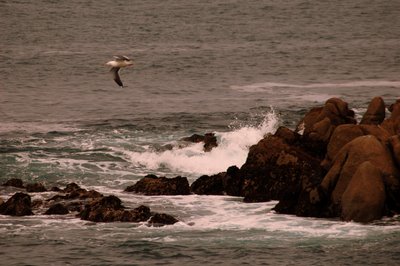 During my time in monterey I tried to get some shots of cormorants and as we can see these little bastards are hard to catch. Its nearly impossible to get a nice sharp picture with a 300mm lens. Anyway the main problem with birds is they are moving, moving objects tend to blur so we have a lost in details. To fight against this we can use either a flash to freeze the motion ( to far away) or use a really high shutter speed ( problem underexposure) so we change to higher sensity (grain). So to find the right balance is the main question.
During my time in monterey I tried to get some shots of cormorants and as we can see these little bastards are hard to catch. Its nearly impossible to get a nice sharp picture with a 300mm lens. Anyway the main problem with birds is they are moving, moving objects tend to blur so we have a lost in details. To fight against this we can use either a flash to freeze the motion ( to far away) or use a really high shutter speed ( problem underexposure) so we change to higher sensity (grain). So to find the right balance is the main question.
This picture was shot at 300m, F5.6, 1/800, iso 400 Another example for the grain of a higher iso is This picture was shot at iso 800, cause it was during the late afternoon and it was cloudy. I prefer to have some grain in my pictures and more details instead of just a blurry unsharp picture.
Another example for the grain of a higher iso is This picture was shot at iso 800, cause it was during the late afternoon and it was cloudy. I prefer to have some grain in my pictures and more details instead of just a blurry unsharp picture.
When you zoom into this picture you will notice the small ammount on grain, nothing serious and it also could be removed with some software like NoiseNinja if you want to spend 40$ for it.
This picture was shot at 300mm, F6.3, 1/2500 and, iso 800. This picture was a shot in from a fishtank in the Monterey Bay aquarium.
This picture was a shot in from a fishtank in the Monterey Bay aquarium.
First mistake was to shot from the side. Cause so we have a gradient in the picture. But the nice things are the wounderfull colors in this shot and the main jelly fish is crisp and sharp ( for the conditions ) We dont have a high problem with noise here ( shot at 800 iso) because there is a very high contrast in this picture.
As we can see the other jellyfish are kinda blurry, cause stupid me forgot to set a higher F than the camera decided. I tend to forget this. The right would be F8/F11 to get an overall sharp picture of them. Maybe I should switch back from the Programm modus to Aperature priority modus. This would give me under this condition way better shots. One day I will learn this to analyze it right before I shot a picture. Another problem is my lens. As you can see on the corners on the pictures it tends to vignet ( damn whats the right work, dict.leo.org is ofline). This is lens specific and I paid for this lens 80$ or so. I think I can accept that its not perfect and step up to a better lens ones I can afford this. You can reduce this effect a little with removing the UV-Filter.
This shot was taken at 28 mm, F3.5, 1/50, ISO 800
As far as filter go, I don't have the money to use some right now. I want to get a circular polarizer and a nd-gradiant filter arround 0.3 - 0.5. A warming filter would be an idea, but I can create the same effect afterwards with photoshop/gimp. Also important to mention is to buy the right size. Its better to by all filter in the same size, 77mm in my case and get some step up filter. So you don't have to buy the filter again when you get another lens. The best example for wrong focus setting we have in the picture of the left. The idea was to have the seagul and the wave in focus. As we can see the waves are nice and the bird is sadly blurred. This happens because of the depth of field of large telezooms when there wideopen. In this case if would be perfect to stop the lens down to F11 . We have a shutterspeed of 1/2000 in this picture, so we would be ok with down to 1/1000 or even 1/500 to get a sharp crisp picture and still have the waves breaking without blurring.
The best example for wrong focus setting we have in the picture of the left. The idea was to have the seagul and the wave in focus. As we can see the waves are nice and the bird is sadly blurred. This happens because of the depth of field of large telezooms when there wideopen. In this case if would be perfect to stop the lens down to F11 . We have a shutterspeed of 1/2000 in this picture, so we would be ok with down to 1/1000 or even 1/500 to get a sharp crisp picture and still have the waves breaking without blurring.
This shot was taken at 300 mm, F5.6, 1/2000, ISO 200
Wednesday, April 19, 2006
Subscribe to:
Comments (Atom)